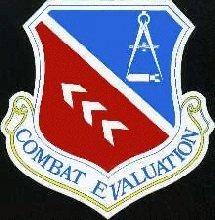

10, 9, 8, 7, 6, 5, 4, 3,
2, 1, HACK! These are the words so familiar
to many military people. They mean different things to different people.
To some, they mean a time synchronization; a time hack. To others, they
mean BOMBS AWAY!

There hasn't been a lot of information recorded about the
Autotrack Radar
career field, compared to some others. Officially listed as Air Force
Specialty Code (AFSC) 303X3, the "X" varies with "skill
level,"
that is, 3, 5, or 7. These numbers represent semi-skilled, skilled, and
technician, respectively.

The 303X3 career field, afterwards called 303's, was
established in 1939.
During that time, the Air Force did not exist; the United States'
airpower was the Army Air Corps. Radar units were assigned to the
Army Air Corps, Signal Corps. These were the early stages of radar
development. The 303's, called the 3903rd Bomb Squadron, had one of the
newest systems "on the market," a fire-control radar dubbed the SCR-584.
The "SCR" stood for "Signal Corps, Radar." This radar later
evolved into
the AN/MPS-9. In later years it was paired with the
OA-215 plotting board
and renamed the AN/MSQ-2.

The "miscue" 2, as it was affectionately referred
to, made up two semi-
trailers, one housing the MPS-9 and the other housing the OA-215.
Originally, the OA-215 was designed to be a shipborne system. The MPS-9
was initially designed as a fire-control radar system. 90 millimeter Anti-
Aircraft Artillery (AAA), or "triple 'A'" guns were "slaved"
to the radar.
"Slaving" involved using the radar pointing angles
and ranges to direct
the guns toward the target. MPS-9s were deployed in England during
World War II.

After the MPS-9 came the M-33. The MPS-9 was an "S"
band system,
operating at 2750 MHz. The M-33 could be fitted with a "back-pack"
for "S" or "X" band. The back-pack was the
receiver/transmitter portion
of the radar. It included the magnetron transmitter and the first three
stages of the heterodyne receiver system. The "X" band transmitter
operated at frequencies between 8500-9600 MHz. This was also a fire
control system but it was more accurate than the MPS-9 for three major
reasons. It operated at higher frequencies, its antenna beamwidth was
1.25 degrees instead of 3 degrees, and it used 400 Hz synchros instead of
60 Hz synchros. This provided smoother tracking and slaving data.

The M-33 had a maximum range of 40 Kyds. There were basically
two
options available, the M-33C and the M-33D. The M-33C had 90 mm guns
while the M-33D had 120mm guns. The maximum range was later increased to
100 Kyds and the system was renamed the AN/MSQ-39. The
'39' also included
improvements in the analog computer/plotting board area. The plotting
board was a vertically mounted unit with two "pen and boom"
assemblies.
The computer would transform radar "polar" data to
"rectangular" data and
send it to the plotting board pen and booms. This could show the radar's
current pointing position.

More modifications were made and the MSQ-39 became the MSQ-46.
These
were not significant modifications to the existing system, rather, some
items were removed. One of the things removed was the extra plotting
board used for "altitude plot."

Another system was introduced, the MSQ-35. The MSQ-35 was also sheltered in a semi-trailer. Instead of using the fresnel lens antenna, the 35 used a cassegrain antenna. The cassegrain antenna incorporated a parabolic reflector and a hyperbolic subreflector. The parabolic reflector was approximately the same diameter as the fresnel lens; 8 ft. By using the cassegrain configuration rather than the lens configuration and reducing the radar's PRF to 600, instead of 1000, maximum range was increased to 200 kyds. The MSQ-35 received some modifications, such as Beacon Tracking, and became the MSQ-77.

Beacon Tracking employed the practice of having the radar trigger a beacon on the aircraft, which provided a reply pulse. This effectively doubled the maximum tracking range to 400 kyds. The MSQ-77 was modified from a single wheeled semi-trailer configuration into a configuration of transportable shelters. This version was known as the TSQ-81. This same configuration was used in several locations throughout SouthEast Asia, specifically LS-85 in Laos. The site at LS-85 was lost in early March 1968.
Click here for more information on LS-85
To be continued...
This page hosted by ![]() Get your own Free Home Page
Get your own Free Home Page